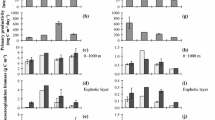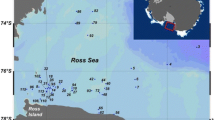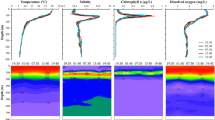Abstract
The day/night vertical distributions of mesozooplankton and micronekton biomass and that of a large number of copepod species to a depth of 1 000 m are described and contrasted in detail from two eastern tropical Pacific stations, the DOME station, in a region of continuous upwelling and the BIOSTAT station, in a non-upwelling area. The effects of various biological parameters such as the zones of primary production and chlorophyll maxima plus physical parameters, such as temperature, salinity and oxygen concentrations, on the distributions of the species and mesozooplankton and micronekton biomass are examined. The thermocline depth appeared to have the greatest influence of all the physical factors on the vertical distribution of the copepod species. The vertical distribution of many species was truncated in the region of the oxygen minimum layer with very few species found below this layer. The vertical distribution of copepod molts in the top 1 000 m showed that the molts probably originated at the depths at which they were found and that the molts from the euphotic zone did not reach the deep water. Copepod species association at different depths showed that few species had common depth distributions during both day and night. The highest degree of association occurred at night in the region of the thermocline. At depths below the thermocline, the degree of similarity in vertical distributions was greatly reduced. The biomass of mesozooplankton at these two stations is compared to other regions of the tropical oceans described in the literature and shown to be among the highest values recorded. The oxygen minimum layer and the thermocline had the greatest impact on species vertical distribution. The biomass of mesoplankton was about twice as high and the number of copepods between three and four times as high at the DOME site as compared to the BIOSTAT site, and evidence suggested that this was influenced by the higher primary production in this region. The difference in micronekton biomass between sites was less, with DOME having about 1.2 to 2.2 the biomass. This suggests that the influence of the higher level of primary productivity at the DOME was evidence of the higher trophic levels.
Similar content being viewed by others
Literature cited
Angel, M. V., P. Hargreaves, P. Kirkpatrick and P. Domanski: Low variability in planktonic and micronektonic populations at 1 000 m depth in the vicinity of 42 N, 17 W; evidence against diel migratory behavior in the majority of species. Biol. Oceanogr. 1, 287–319 (1982)
Blackburn, M., R. M. Laurs, R. W. Owen and B. Zeitzschel: Seasonal and areal changes in standing stocks of phytoplankton, zooplankton and micronekton in the eastern tropical Pacific. Mar. Biol. 7, 14–31 (1970)
Boyd, C. M. and S. L. Smith: Grazing patterns of copepods in the upwelling system off Peru. Limnol. Oceanogr. 25, 583–596 (1980)
Brandhorst, W.: Thermocline topography, zooplankton standing crop, and mechanisms of fertilization in the eastern tropical Pacific. J. Cons perm. int. Explor. Mer 24, 16–31 (1958)
Bray, J. R., and J. T. Curtis: An ordination of the upland forest communities of Southern Wisconsin. Ecol. Monogr. 27, 325–349 (1957)
Brinton, E.: Parameters relating to the distributions of plankton organisms, especially euphausiids in the eastern tropical Pacific. Prog. Oceanog. 8, 125–189 (1979)
Clifford, H. T. and W. Stephenson: An introduction to numerical classification, 229 pp. New York: Academic Press 1975
Clutter, R. I. and M. Anraku: Avoidance of samplers. In: Zooplankton sampling. Ed. by D. J. Tranter, New York: UNESCO 1968
Conover, R. J.: Secondary production as an ecological phenomenon, pp 50–86. In: Zoogeography and diversity of plankton. Ed. by S. Van der Spoel and A. C. Pierrot-Bults. New York: Halsted Press 1979
Deevey, G. B. and A. L. Brooks: The annual cycle in quantity and composition of the zooplankton of the Sargasso Sea off Bermuda. II. The surface to 2 000 m. Limnol. Oceanog. 16, 927–943 (1971)
Deevey, G. B. and A. Brooks: Copepods of the Sargasso Sea off Bermuda: species composition, and vertical and seasonal distribution between the surface and 2 000 m. Bull. mar. Sc. 27, 256–291 (1977)
Dixon, W. J., M. B. Brown, L. Engelman, J. W. Frane, M. A. Hill, R. I. Je. BMPD statistical software 1981. Berkeley: University Calif. Press 1981
Field, J. G., K. R. Clarke and R. M. Warwick: A practical strategy for analysing multispecies distribution patterns. Mar. Ecol. Prog. Ser. 8, 37–52 (1982)
Greenlaw, C. F. and W. G. Pearcy: Acoustical patchiness of mesopelagic micronekton. J. mar. Res. 43, 163–178 (1985)
Grice, G. D. and A. D. Hart: The abundance, seasonal occurrence and distribution of the epizooplankton between New York and Bermuda. Ecol. Monogr. 32, 287–309 (1962)
Harding, G. C. H.: Decomposition of marine copepods. Limnol Oceanogr. 18, 670–673 (1973)
Heron, A. C.: Population ecology of a colonizing species: the pelagic tunicate Thalia democratica. I. Individual growth rate and generation time. Oecologia 10, 269–293 (1972)
Hopkins, T. L.: The vertical distribution of zooplankton in the eastern Gulf of Mexico. Deep-Sea Res. 29, 1069–1083 (1982)
Humphrey, G. F. and J. D. Kerr. Seasonal variations in the Indian Ocean along 110E. III. Chlorophylls a and c. Aust. J. mar. freshwat. Res. 20, 55–64 (1969)
Irwin, B., L. Harris, P. Dickie, P. Lindley and T. Platt: Phytoplankton productivity in the eastern Canadian Arctic during July and August 1980. Canadian Data Rept. Fish. Aquat. Sci. No. 386, 157 pp. 1983
King, J. E. and R. T. B. Iversen: Midwater trawling for forage organisms in the central Pacific, 1951–1956. Fish. Bull. Fish Wildl. Serv. U.S. 62, 271–321 (1962)
Legand, M.: Seasonal variation in the Indian Ocean along 110 E. VI. Macroplankton and micronekton biomass. Aust. J. mar. freshwat. Res. 20, 85–103 (1969)
Li, W. K. W., D. V. Subba Rao, W. G. Harrison, J. C. Smith, J. J. Cullen, B. Irwin and T. Platt: Autotrophic picoplankton in the tropical ocean, Science, Wash. D.C. 219, 292–295 (1983)
Longhurst, A. R.: Vertical distribution of zooplankton in relation to the eastern Pacific oxygen minimum. Deep-Sea Res. 14, 51–63 (1967)
Longhurst, A. R.: Interaction between zooplankton and phytoplankton profiles in the eastern tropical Pacific Ocean. Deep-Sea Res. 23, 729–754 (1976)
Longhurst, A. R.: Relationship between plankton diversity and the vertical structure of the upper ocean. Deep-Sea Res. 32, 1535–1570 (1985)
McGowan, J. A. and P. W. Walker: Structure in the community of the north Pacific central gyre. ecol. Monog. 49, 195–226 (1979)
Ortner, P. B., P. H. Wiebe and J. L. Cox: Relationships between oceanic epizooplankton distributions and the seasonal deep chlorophyll maximum in the northern Atlantic Ocean. J. mar. Res. 38, 507–531 (1980)
Richards, F. A.: Oxygen in the ocean. Mem. Geol. Soc. Am. 67, 185–238 (1957)
Roe, H. S. J.: The diel migrations and distributions within a mesopelagic community in the north east Atlanic. 4. The copepods. Prog. Oceanog. 13, 353–388 (1984)
Rudyakov, Yu. A. and V. B. Tseytlin: Passive sinking rate of marine pelagic organisms. Oceanology 20, 613–616 (1980)
Sameoto, D. D.: Environmental factors influencing diurnal distribution of zooplankton and ichthyoplankton. J. Plank. Res. 6, 767–792 (1984)
Sameoto, D. D., A. Herman and A. Longhurst: Relations between the thermocline meso and microzooplankton, chlorophyll a and primary production distributions in Lancaster Sound. Arctic Biol. (In press)
Sameoto, D. D., L. O. Jaroszynski and W. B. Fraser: BIONESS, a new design in multiple net zooplankton samplers. Can. J. Fish. aquat. Sci. 37, 772–774 (1980)
Steel, R. G. D. and J. H. Torrie: Principles and procedures of statistics, 481 pp. Toronto: McGraw-Hill Book Co. 1960
Subba Rao, D. V. and D. D. Sameoto: Relationship between phytoplankton and copepods in the deep tropical Pacific Ocean off Costa Rica. Bull. mar. Sci. (In press)
Timonin, A. G.: The structure of plankton communities of the Indian Ocean. Mar. Biol. 9, 281–289 (1971)
Tranter, D. J. and J. D. Kerr. Seasonal variations in the Indian Ocean along 110 E. V. Zooplankton biomass. Aust. J. mar. freshwat. Res. 20, 77–84 (1969)
Vinogradov, M. E.: Feeding of the deep-sea zooplankton. Rapp. P.-v. Reun. Cons. int. Explor. Mer. 153, 114–120 (1962)
Vinogradov, M. E.: Vertical distribution of the oceanic zooplankton. IPST translation, 339 pp. U.S. Dept. Int. Doc. No. TT 69-59015 (1970)
Vinogradov, M. E., V. V. Menshutkin and E. A. Shushkina: On mathematical simulation of a pelagic ecosystem in tropical waters of the ocean. Mar. Biol. 16, 261–268 (1972)
Vinogradov, M. E. and N. M. Voronina: Influence of the oxygen deficit on the distribution of plankton in the Arabian Sea. Oceanology 1 670–678 (1961)
Weikert, H.: The oxygen minimum layer in the Red Sea: ecological implications of the zooplankton occurrence in the area of the Atlantis II deep. Meeresforsch. 28, 1–9 (1980)
Weikert, H.: The vertical distribution of zooplankton in relation to habitat zones in the area of the Atlantis II deep, central Red Sea. Mar. Biol. 8, 129–143 (1982)
Wheeler, E. H.: Copepod detritus in the deep sea. Limnol. Oceanogr. 12, 697–702 (1967)
Wiebe, P. H.: A computer model study of zooplankton patchiness and its effects on sampling error. Limnol. Oceanogr. 16, 28–29 (1971)
Wiebe, P. H.: A field investigation of the relationship between length of tow, size of net and sampling error. J. Cons. int. Explor. Mer 34, 268–275 (1972)
Wiebe, P. H., S. Boyd, and J. L. Cox: Relationships between zooplankton displacement volume, wet weight, dry weight and carbon. Fish. Bull, U.S. 73, 777–786 (1975)
Wishner, K. F.: The biomass of the deep-sea benthopelagic plankton. Deep-Sea Res. 27A, 203–216 (1980a)
Wishner, K. F.: Aspects of the community ecology of deep-sea benthopelagic plankton, with special attention to gymnopleid copepods. Mar. Biol. 60, 179–187 (1980b)
Wyrtki K.: The oxygen minima in relation to ocean circulation. Deep-Sea Res. 9, 11–24 (1962)
Yashnov, V. A.: Vertical distribution of the mass of zooplankton in the tropical region of the Atlantic Ocean. Oceanology 4–6 136–141 (1962)
Author information
Authors and Affiliations
Additional information
Communicated by R. W. Doyle, Halifax
Rights and permissions
About this article
Cite this article
Sameoto, D.D. Influence of the biological and physical environment on the vertical distribution of mesozooplankton and micronekton in the eastern tropical Pacific. Mar. Biol. 93, 263–279 (1986). https://doi.org/10.1007/BF00508264
Accepted:
Issue Date:
DOI: https://doi.org/10.1007/BF00508264




